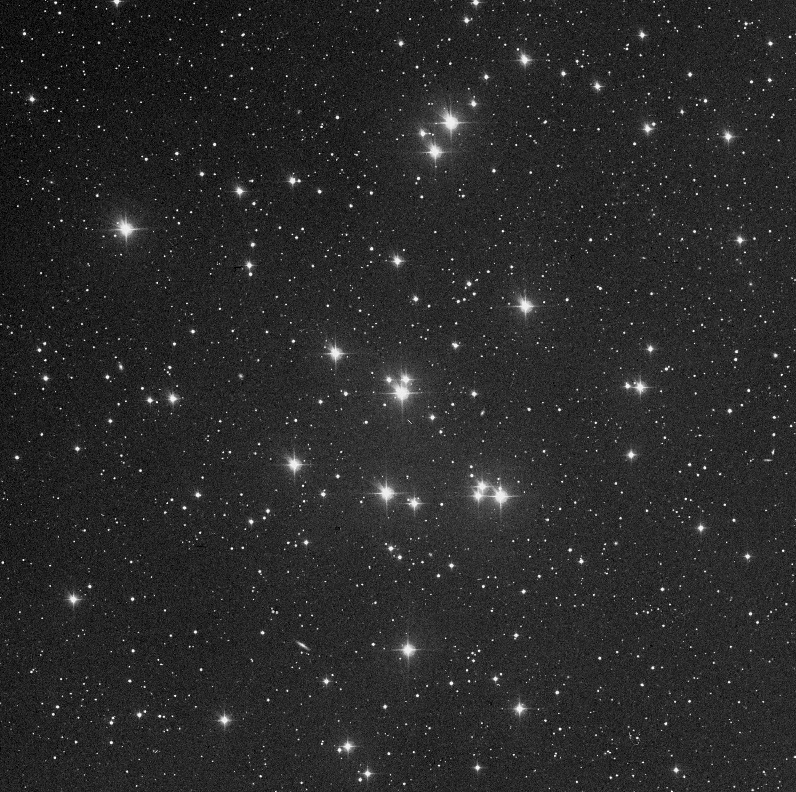Objects M44 (Beehive, NGC 2632, Collinder 189, Melotte 88, Raab 75, OCL 507) followed by Jupiter

Conditions: clear with a few isolated clouds low in the West. Seeing was excellent with only momentary quiver. Transparency was good but towards the end of the session became poor followed by complete cloud cover.
- Observations: Made between 20:55 and 22:20 GMT
- Airmass at time of observation: M44 -1.5 , Jupiter- 1.3
It’s been a while where the forecast of clear skies and the clear skies actually appearing, but last night it did what is said on the tin- well for a few hours anyway.
I adjusted the pier back to vertical back in December and it’s taken until last night to adjust and fine tune the polar alignment. This is the first time I have tried drift alignment. Before now I’ve relied on the Losmandy’s polar alignment scope and never found any problems with either field rotation, or objects slowly creeping out of view after 15 mins. However, the R.C’s 2 metre focal length is a lot less tolerant of a misaligned mount, so decided it needed doing properly.
I’ve read a few articles on the process and while all very comprehensive, most seem to spend ages trying to explain what up or North through the eyepiece. Rather than try and figure all that out, I just went through the process of watching when the star moved in declination and adjusting the appropriate axis on the mount to compensate. If the speed of movement got worse, I know I was adjusting the wrong way. OK, the whole process took a couple of hours, but now I have made notes of which direction I need to make my adjustment when the stars move up in the eyepiece, next time I have to do this, it will be a doddle.
Consensus of the various articles seem to settle on no star movement in declination for at least 5 minutes and ideally 10. With a x2 Barlow on a 10mm reticule eyepiece, I saw no movement after 7 minutes on each axis and settled for that. As a test we placed Jupiter in the centre of a 4mm TMB eyepiece and left it there while we went for a cup of tea. 20 minutes later, Jupiter hadn’t moved much and was still close to the centre of the FOV. I figured this was a good test, so went ahead and started to rebuild Gemini’s alignment model.
In between the 5 minute gaps of polar alignment, I got the binoculars out and had a look at M44, the Beehive cluster. The last time I viewed this, I didn’t make any log entry, but certainly remember seeing this open cluster many years ago through my ETX90 and marvelling how pretty it is. While I don’t see a beehive, it does resemble a kids drawing of a Christmas tree. The binoculars are perfect for viewing M44 as the whole cluster fits within the 7 degree FOV with room to spare. Starting at the core, there are four stars ( H3428, HR3429, SAO 98032 and SAO 98030) that make a trapezoid. The North Western of these is HR 3428, a visibly orange 6.8mag double star. The colour wasn’t particularly obvious, but through a small scope like the ETX, it is.
Moving out from the trapezoid is the kids Christmas tree shaped tall triangle which is so obvious and which explains the more familiar name of the Beehive. However when you add the two stars HD 73974 and HD 73449 to either side of the triangular asterism, it changes from a beehive to a dancing girl ( Sadly no Romulan Star Trek connections in this description ). It’s at this point I then saw it chage again to an almost perfect Pentagon. This is interesting as when I checked out the star chart, the stars that must make up the Pentagon, produce a shape that is quite squashed!
Moving out one final time, this whole collection of asterisms are contained within another inverted triangle made up of HD 73729, HD 73345 and SAO 98019.
y the time I completed my polar alignment, high thin cloud started to roll in, so before packing up, we took one glimpse of Jupiter again. This was fortuitous as Io had just completed a transit and her shadow was just visible on the Southern equatorial belt. While we had missed observing the GRB AGAIN, the shadow transit was the icing on the cake and is an event I’ve not seen before. By 11:30, much thicker cloud cover had come in calling this technically successful and enjoyable session to an end.
While I’ve used the TMB 4mm lots of times on the refractor, this is the first time I’ve used it for planetary observation through the R.C. While the image was poor, there were few moments of clarity. This was quite surprising as that high thin cloud seemed considerable and is enough that might have put me off opening up the observatory. It makes me wonder how poor conditions could get and still be able to see something useful.